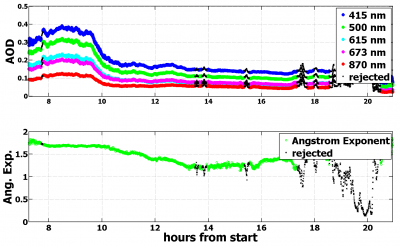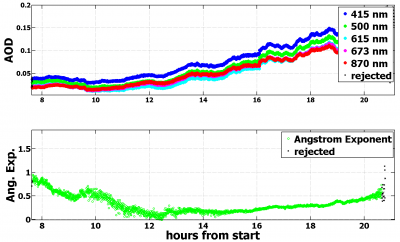Aerosol Data From Pico Observatory Now Part of Value-Added Product
Published: 11 March 2013

AOD measures the total aerosol burden in the atmosphere. The spectral dependence of AOD, typically described by the Angstrom exponent, is also an indicator of particle size. Small Angstrom exponent values (near zero) indicate the presence of large particles, and vice versa.

During the AMF1 deployment at the Azores, a supplemental site with an MFRSR was set up at the Pico Observatory. Recently, data from this supplemental site were added to the AOD VAP. Clean days with small aerosol loadings (AOD less than 0.1 at 500 nm) were observed quite frequently at this site. The VAP produces reasonable AODs even for these days. The figures to the right show examples of AODs collected for days with moderate and low aerosol loadings. It is expected that a comparison between AODs from the main Azores deployment and from Pico Observatory will provide great opportunities to better understand aerosol entrainment processes and complex issues associated with aerosol-cloud interplay.
More information is available at the VAP web page. To access these data, log in to the Data Archive. (Go here to request an account.)
The ARM Climate Research Facility is a DOE Office of Science user facility. The ARM Facility is operated by nine DOE national laboratories, including .
Keep up with the Atmospheric Observer
Updates on ARM news, events, and opportunities delivered to your inbox
ARM User Profile
ARM welcomes users from all institutions and nations. A free ARM user account is needed to access ARM data.


















